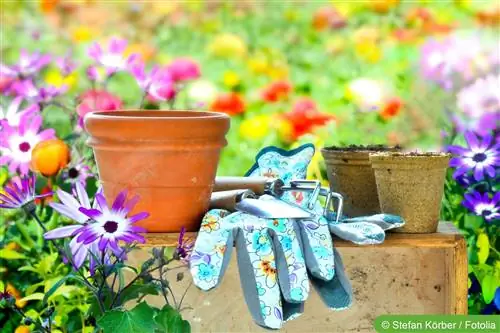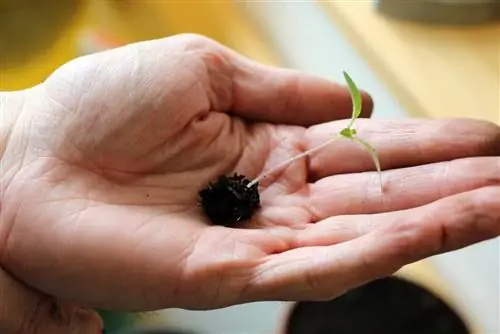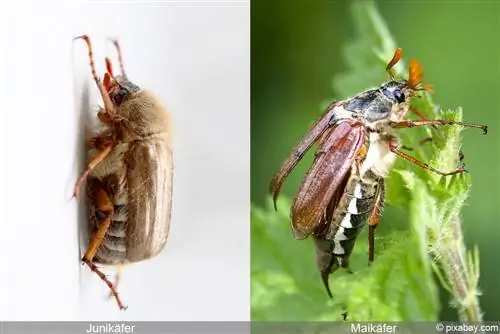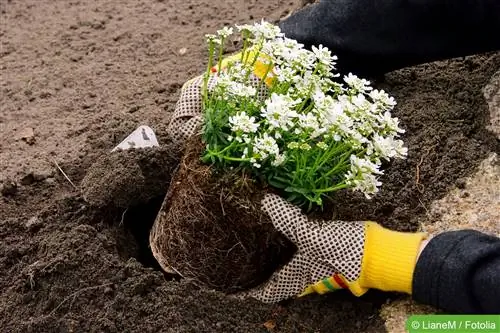- Author admin [email protected].
- Public 2023-12-17 03:39.
- Last modified 2025-01-24 12:45.
In June the garden unfolds in its full beauty. Something is blooming everywhere, the bushes and trees provide cool shade. Now the days are the longest and there is something to do everywhere. Even during the coffee break, the cup goes into the garden, where it is often simply left somewhere to change something here and there, or to cut off something that has faded.
Care measures in June
- Now is the ideal time to sow biennial summer flowers. June is also the best time for some perennials. It is best to sow in partial shade, in the shade, so that the soil does not quickly lose the moisture that the seeds need to germinate. Potted plants and some perennials that can be propagated through cuttings can now be cut and placed in a moist soil-sand mixture. A hood placed over it ensures tense air, which promotes root formation.
- All hell breaks loose in the rose bed in June. Many roses are already blooming at this time. A walk among the roses is a special experience. But there is enough to do here too. Any dead flowers must be removed regularly and the roses must be checked for pests so that we can react as quickly as possible. But you should remember: It doesn't always have to be poison. A tried and tested home remedy helps to get rid of aphids quickly. The mixture of water, soft soap and a splash of spirit is quick to prepare, is effective and is also completely non-toxic.
- Potted plants need regular water and sufficient nutrients in summer. Some plants, such as Brugmansias (angel's trumpets), are real drinkers and eaters. They absolutely need water every day and also frequent fertilizer. The fertilizer promotes bud formation and growth. Most potted plants can also tolerate the high dose of fertilizer, so as long as no children or pets come near the rain barrel, you can put the fertilizer directly into the rain barrel and water all potted plants with this mixture.
- Everything is going its own way in the vegetable garden. You can still sow lettuce, lettuce and radishes so you always have fresh supplies on a regular basis. It is not yet too late to plant early vegetable plants such as cucumbers, pumpkins, tomatoes, etc. The less well-known sheep cold can still be expected in June. Observe the weather and, if necessary, protect vegetable plants (especially young vegetables) from the cold with foil or fleece.
- Freshly purchased potted plants should be left in a partially shaded place for a few days after purchase before placing them in the sun. The plants in the nurseries are rarely in the sun; they should get used to the new lighting conditions. However, if you plant them immediately, make sure that the soil remains moist. However, waterlogging should be avoided to avoid root damage.
- Remove faded flowers regularly in the perennial bed. Tall, late-flowering perennials, such as tall asters, should be cut back slightly in mid-June. Pruning allows the plants to grow more compactly, but does not stop flowering. Cutting stimulates the formation of shoots and buds. Perennials that have already faded can be cut cleanly about 30cm above the ground. These sprout willingly again and give us a second (albeit not as lush) flowering in late summer and early autumn.
More gardening tips for June
Berries are ripening, potato plants are growing rapidly, lawn care needs to be done and the rock garden needs care. There is a lot to do in June, but also the first harvest fun. Ornamental gardens now need just as much care as kitchen gardens and fields. There is life in the garden in June and it shows. The first ripe berries attract birds, pests attack the plants, and in between the next year's fruit tree blossoms still have to be prepared.
Potatoes and other vegetables
The potato plants grow very quickly in late May and early June. When they have reached a height of around 20 cm, they need to be piled up. In June, the Colorado potato beetle arrives in many areas of Germany - it eats the leaves of the potato plant, which is weakened so much that it hardly produces any potatoes. Very fine nets over the plants keep the beetles away in a biological way, but there are also appropriate pesticides.
Tomato plants are also quite tall in June. In order for them to grow well, they now need to be tied up. Miserliness is now forming. To protect the plants, the shoots should be carefully broken off in June, if possible without damaging the trunk. Otherwise they take away a lot of the power from the plants that is missing when producing flowers and fruits.
Vegetables that are to be harvested twice a year must now be sown at night. This applies to peas, beans, cabbage and beetroot. It seems early, but the plants need time to grow and mature. Even if it is faster than the first sowing due to the higher temperatures and now very sunny days.
Cucumbers can be harvested at the end of June if they are planted early enough. However, this is rarely the case outdoors without a greenhouse. Cucumbers must be thinned, which means the shoots must be shortened. The main shoot is usually cut after the sixth leaf, the side shoots after the seventh leaf. Due to the limited growth, the plant has more strength and usually produces more fruit.
Fruit trees and bushes
Everything that bears fruit needs to be watered well in sunny and warm June. This also applies to trees and bushes. Young plants in particular do not have such deep roots, they cannot reach the deeper, water-bearing soil layers and are dependent on watering. Fruit trees and bushes do hard work in June and need to be fertilized to ensure a regular supply of nutrients. The trees are already producing fruit. If there are too many, the fruit sets should be thinned out to ensure a high-quality and safe harvest. Some trees produce too many fruits and lack the strength to fully develop and ripen them all.
Fruit trees are cut out now so that they will bloom profusely again next year. This is the so-called summer cut. And of course there is also harvesting: cherries, strawberries, gooseberries and currants are ripe in June. To prevent cheeky birds from stealing the ripe fruit, you should cover bushes and hedges with bird nets. This means you can really let the fruits ripen outdoors without suffering too serious a loss in harvest. Of course, the fruits will continue to ripen after they have been picked, but may have less aroma.
Strawberry plants need attention now too. Those to be renewed must be removed after harvest. Runners are welcome to take root if desired. You should also remove those that are not needed for breeding. Because they take away the strength of the plant. Remember to carefully loosen and rake the beds.
Grapevines
A lot is happening with wine in June. The shoots must be tacked on; stingy shoots can be carefully cut out. At least that's traditionally the case - miserliness robs plants of their strength, it was always said. Today we know that stingy shoots develop exactly the same organs as the other shoots, but a little smaller because they grow later. They promote the ripeness of the grapes and should therefore be retained. There is one exception: where the thick foliage of the shoots extends into the grapes, it can be carefully pruned out. This prevents fungal infections. Heavy foliage should be trimmed back in June anyway - for the reasons mentioned.
Lawn and hedges
The lawn actually just needs to be mowed in June. Of course, in long dry periods it needs water so that it doesn't turn brown, but that's all you need to do.
Hedges are cut towards the end of June. Climbing bushes now need to be tied up so that they have support. For roses that are being replanted, the wilted flowers should be removed so that they do not produce fruit. The formation of fruits firstly costs the plant energy and secondly can reduce the number of further flowers. Withered flowers should also be removed from perennials - this particularly applies to perennials in the rock garden, whose flowering period ends in June in many cases.
Flowers
The flowering plants for the following year are sown in June: forget-me-nots and pansies, columbines and mallow, foxgloves and carnations are supposed to bloom in the spring and summer of the next year. They can already be sown outdoors.
Tips for speed readers
- Hill potato plants when they have reached a height of 20 cm and spread fine nets against the Colorado potato beetle in mid to late June.
- Tie up tomato plants and remove any shoots if necessary.
- Resow peas, beans, beetroot and cabbage for the second harvest of the year.
- Cucumbers are tipped, the first early cucumbers can be harvested.
- Water fruit trees and bushes well.
- Prune fruit trees back a little for next year's blooms.
- For fruit trees that have a lot of fruit sets, remove some so that the remaining fruits can fully develop.
- Cherries, strawberries, gooseberries and currants can be harvested. Cover bushes and hedges with bird netting.
- Remove old strawberry plants after harvest and allow the runners to take root. Remove unnecessary runners.
- Pin vines. Cut back heavy foliage slightly to prevent fungal infections.
- Remove stingy shoots from wine if the leaves grow too close to the grapes.
- Mow the lawn and water it when it is dry.
- Cut hedges towards the end of the month.
- Tether climbing bushes.
- For remontant roses, remove wilted flowers to prevent fruiting.
- Remove wilted flowers from perennials (especially in rock gardens).
- Sow spring and summer bloomers for next year.






